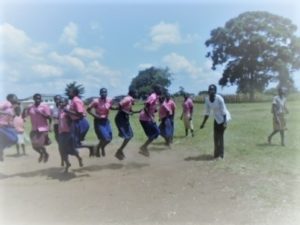Girls reveal: Four (4) Most Hindering Factors to their Education Pursuit, Lango sub-region

GLORIA: the official from GLOFORD chats with teenage girls in a primary school in Loro, Oyam district as the girls reveal issues most pressing to them
Girls reveal: Four (4) Most Hindering Factors to their Education Pursuit, Lango sub-region
By Tonny Abet
The subsequent voice of teenage girls in this article is a true incerpt from the July 2018 research study conducted in Loro sub-county, Oyam district in Northern Uganda, East Africa by GLOFORD Uganda with financial aid from OXFAM.
The case of a teenage girl, Sara
Fairly tall and dark skinned in complexion, Sara was definitely a beautiful 16 year old teenage girl living with her parents in senior quarters of Lira Municipality. It had been the 10th year utterly confined in the gated home except when she was in the boarding school that she attended in Wakiso, Uganda. Sarah was in her 2nd term holiday, she was now in Form 4 awaiting the Uganda Certificate of Education examination. Thanks to the new high paying job, Sam, her father landed with an international NGO which gave their family a financial facelift in the midst of stringent Uganda’s economic terrain to afford an executive home in Lira Municipality. Now, a strange protrusion had started evolving from the teen girl’s belly. Sarah often looked innocent and calm. The parents were pained by the strange clinical condition, the medical examination on a Monday morning did no better but frustrate Sam, her biological father when the doctor revealed there was no alien bug growing in her belly but the young girl was simply expecting, she was expecting a baby boy and more over she was in the 4th Month of her unplanned teenage pregnancy. She had conceived with a fellow teenage boy while in school. Tight lipped, the father wept and was so dismayed.
The other side
So many stories around the teenage girls continue to disinterest parents and caretakers. The discussion can never be one sided, the girls have acted irrational in countless scenarios. Many have gotten pregnant, eloped and cohabited without any single sense of reasoning.
However, the teenage girls have substantive reason that show they have been hard pressed and pushed against the walls to act inversely. It is in this breathe that we want to review the revelations from the teenage girls of Loro, Oyam district in Uganda for factors they consider most hindering to their education pursuit.
On 20th July, 2018, a research team from GLOFORD Uganda under the financial enablement from OXFAM launched into the heart of Lango sub-region. This sub-region is in the Northern part of Uganda, East Africa. A small area sub-county called Loro in Oyam district was sampled for this crucial study. The key thing about this sub-county is that it is one of the many sub-counties recovering from the 20 years of war. The sub-county is pierced through by a decent highway connecting Kenya to South-Sudan through Uganda.
The survey was done in 13 (thirteen) government headed primary schools and 1 senior secondary school. Specially designed and pretested questionnaires tools focused on digging deep into the dynamics of menstrual hygiene management, girl child education, early girl child marriage and school sanitations were administered to school pupils/students, teachers, administrators and parents.
The key Objective of the survey was to document Knowledge Attitudes and Practices (KAP) of the target communities and district as regards menstrual hygiene management, girl child education, early girl child marriage and school sanitation.
THE FOUR ISSUES (4) THE GIRLS IN LANGO SUB-REGION NEED ADDRESSED

Gloria: the Girl Child Voice project officer (assistant) takes a play time with pupils in a primary school in Loro, Oyam district on 7/08/2018
- Parents are not giving the teenage girls sanitary pads.
Face 1
All possible means should be devised to get parents (fathers) responsible and providing their daughters with the sanitary pads. This may include reactions from school administrators and other stakeholders in the community to push negligent parents accountable.
Face 2
The parents who don’t provide sanitary pads are characterized as very impoverished class of parents (earning less than a dollar a day). The middle class parents (in context of Loro, Oyam district) often provide the sanitary pads. The government is on the frontline in making resources equitable to citizens of Uganda. if one can’t afford ant-malarial tablet for the dying child, how unreasonable would we wish he gets the sanitary pad for the girl or even pay her in school. Can the environment for agriculture be enhanced to allow these impoverished parents earn better?
2. Facilities in schools do not favour girls who are menstruating.
No specified facility for adolescent girls to clean up and change during their menstruation at school. Can the school administration in collaboration with parents plan, allocate resources and construct special rooms to meet this important need?
3. The boys are always teasing the girls who are undergoing menstruation.
Most of the boys have limited knowledge about menstruation. They need to be specially sensitized to harmoniously co-exist especially when the girls are undergoing menstruation periods.
4. Limited knowledge and slow adaptation of better menstrual hygiene management method among teenage girls and parents. There is need to put spirited sensitization and getting the stakeholders accountable.

